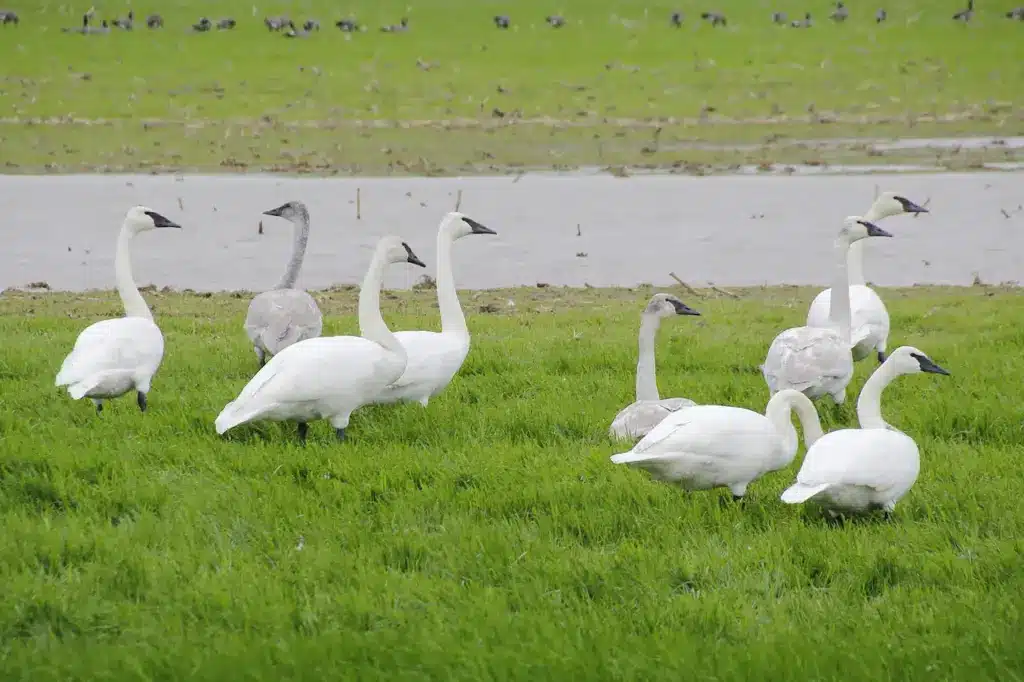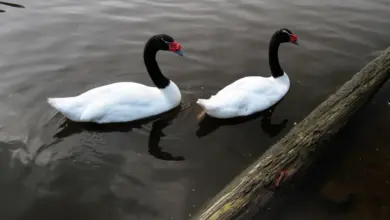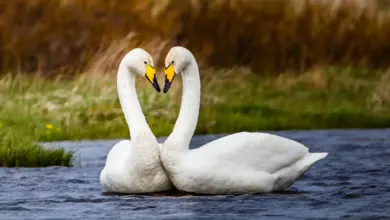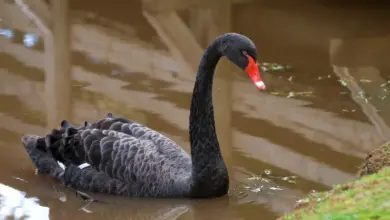The Trumpeter Swans (Cygnus buccinator) – also known as Bugler Swan – is the largest North American waterfowl species.
It is closely related to the Eurasian Whooper Swan, and some authorities even consider them to be conspecific (one and the same species).

The male is called a “cob” – from Middle English cobbe (leader of a group); the female “pen,” and their chicks are known as “cygnets” – from the Latin word for swan, cygnus.
The Trumpeter Swans are native to North America, where they naturally occur in Canada and the United States.
In the past, Trumpeter Swans nested over much of North America. However, between the 1600s – 1800s, the Trumpeter Swans were hunted for their feathers, as their largest flight feathers were in demand for quill pens.
During the 19th century, hunting and again the demand for their feathers (for fashionable hats) and skins (used to make ladies’ powder puffs) depleted their numbers. By 1940, they were hunted to near extinction in the lower 48 states.
In recent areas, populations have recovered in some areas – particularly in the Pacific Northwest, and conservations efforts are ongoing to reintroduce them to many other parts of their historic range.
Trumpeter Swans were named for their deep, sonorous calls. These majestic swans have a snowy white plumage that contrast with the jet-black bill, feet and legs.
Trumpeter Swan pairs typically bond for life and pairs stay together throughout the year, including moving together in migratory populations. However, it has been observed that some of them switch mates over their lifetimes, particularly after nesting failures, and some that lost their mate did not mate again.
If a male pairs up with another younger female, she will typically join him on his territory. If he pairs up with an older female, he will go to hers. If a female loses her mate, she will usually pair up quickly – usually choosing a younger male.
Bonded pairs tend to remain together year-round; however, outside the breeding season, they are highly social and often congregate with large numbers of other swans. During the breeding season, pairs will, however, aggressively defend their territories.

Alternate (Global) Names
Chinese: ???? … Czech: Labut trubac, labu? truba? … Danish: Trompetérsvane … Dutch: Trompetzwaan … German: Trompeterschwan … Estonian: ameerika laululuik (trompetluik) … Finnish: trumpettijoutsen, Tumpettijoutsen … French: Cygne trompette, Cygnus trompette … Hebrew: ?????? ?????? … Italian: Cigno trombettiere, Trombettiere … Japanese: nakihakuchou, ??????? … Norwegian: Trompetersvane … Polish: labedz trabiacy, ?ab?d? tr?bi?cy … Russian: ??????-?????? … Slovak: labut trúbivá, Labut’ trúbivá … Spanish: Cisne Trompetero …Swedish: Trumpetarsvan
Distribution / Migration
Trumpeter Swans occur naturally in south-central and eastern Canada; southern half of Alaska and the northern parts of the United States, stretching from Washington State, northern Idaho, Montana, northern Wyoming, North and South Dakota, Nebraska, the northeastern corner of Kansas, Minnesota, Iowa, northern Missouri, Wisconsin, Illinois, Indiana and Michigan (Great Lakes states). About 75% of the world’s total number of Trumpeter Swans are found along the Pacific Coast.
Trumpeter Swans that breed in Canada and Alaska move southwards as waters begin to freeze. In early spring, they arrive back in their breeding grounds soon after ice melt.
However, contrary to other bird species that migrate over thousands of miles, Trumpeter Swans only migrate over relatively short distances.
Many populations in the United States are non-migratory – particularly released / reintroduced populations. Females in particular tend to remain in their home range, while males are more likely to expand into other areas.
During mild weather, they tend to be widely dispersed, congregating in freshwater and estuarine wetlands and flooded farm fields along the coast. As the weather turns colder and the freshwater areas freeze, they remain on the estuaries, as they don’t freeze due to tides and salt water.
During the spring and fall migrations, flocks of Trumpeter Swans are often seen flying in “v” formation. Their flight speed is clocked at 25 to 60 miles per hour (40 to 96 kilometers per hour) as they follow clearly defined paths close to bodies of water. They usually use similar routes to and from their breeding territories.
Winter Territories
In October to early November, Trumpeter Swans typically migrate to their wintering grounds. Swans without young typically leave first and family groups follow soon after.
They winter in the southern tier of Canada, the eastern part of the northwest states in the United States as far south as Pagosa Springs, Colorado.
Trumpeter Swans that breed in interior Alaska usually winter in tidal estuaries found between southeastern Alaska, southwestern Canada and the Columbia River in western Washington.
A large portion (nearly 40% in 1995) of the Pacific Coast trumpeter swan population winters along south coastal British Columbia (particularly on eastern Vancouver Island).
Some migrate south to northern United States, where they winter along with resident populations.
Their winter around lakes, along streams, springs, rivers and in reservoirs.
Breeding Territories
Mid-to-late February through April, Trumpeter Swans will make their journey back to their breeding territories in northwestern and central North America, with the largest numbers of breeding pairs being found in Alaska.
They navigate through mountain ranges and move north with the spring thaw. On their way north, they gather on lakes in central British Columbia and southern Yukon. In April, thousands of Trumpeter Swans gather around Marsh Lake near Whitehorse in Canada’s Yukon. Most arrive in their breeding territory in late April or early May.
Trumpeter Swans breed along large shallow ponds, freshwater marshes and wide slow rivers in northwestern and central North America – with the largest numbers of breeding populations occurring in Alaska.

Description
Size:
The Trumpeter Swan is just about the largest swan species in the world.
Trumpeter Swans average 54.3–62.2 inches (138–158 cm) in length, and have a wingspan of 7 – 8 feet (2.1 – 2.4 meters).An adult Trumpeter Swan stands about 4 feet (1.2 meters) tall.
They weigh between 17 – 28 lbs (7.7 – 12.7 kg). The males tend to be larger than females with an average weight of 28 lbs (12.7 kg); females weigh about 22 pounds (10 kg).
Among the North American waterfowl, the Trumpeter Swan is rivaled only by the Mute Swan in terms of size; however, the Trumpeter Swan is usually longer-bodied. In Eurasia, the Whooper Swan is close to its size.
Physical Features:
- The plumage is all white; except the head and neck are often stained a dull tan or orange color due to exposure to iron-rich waters and mud as they dive under water to forage for food. They have a thick layer of down that protects them in subzero temperatures. Like all water birds, they spend a good amount of time preening their feathers. As part of preening, the swan presses the bill against an oil gland (located at the base of its tail) to extract a greasy fluid that they redistribute over their plumage to waterproof the feathers.
- They have a long, straight neck – and fly with their neck stretched straight out in front of them.
- The black bill is broad and flat, with fine tooth-like serrations along the edges that strain water as they eat aquatic vegetation. Along the base of the lower bill is orange-red stripe.
- Their short legs and webbed feet range in color from dark grey to black.
The Molt:
Trumpeter Swans molt once a year (during the breeding / summer season), at which time they temporarily lose their flight feathers on the wings and the tail, leaving them flightless for about a month.
The females goes through this molt two to three weeks after the chicks hatched; and the male goes through this about one month later when the female has completed her molt.
As flightless swans are particularly vulnerable to predation, they may seek shelter in taller vegetation.
The staggered molt ensures that at least one adult is capable of flight and defending the chicks.
Juveniles
The Cygnets have a light grey plumage. As they mature, the pinkish-grey legs and feet turn yellowish grey to dull black; and their grey bills with pink tips turn completely black.
They attain their adult, all-white, plumage when they are about 1 to 1.5 years old.
Similar species
- Tundra Swans are more common than the Trumpeters Swan. 80% of all Tundra Swans have distinct yellow spot in front of the eye (rarely, this yellow spot can also be seen in the Trumpeter’s Swan). The Tundra Swan’s bill is slightly dish-shaped, while the Trumpeter’s bill is more wedge-shaped. The Tundra Swan has a rounded head; the Trumpeter’s head is angular. Trumpeter Swans have a red stripe on the edge of its lower bill. However, Tundra Swans may also have this stripe. The most definite way to id them is by their differing calls.
- Mute Swan has a more curved neck (compared to the Trumpeter’s straight neck) and an orange bill (compared to the Trumpeter’s black bill).
- Snow Goose is significantly smaller with a wingspan of only about 3 feet. The Snow Goose has a shorter neck, black wingtips and flesh-colored bill and legs.
- The White Pelican has a short neck, large yellow or orange bill, orange legs, and black flight feathers.
Breeding / Reproduction

Calls / Vocalizations
Their calls consist of a loud, deep, sonorous, trumpet-like honking sound – hence the bird’s name “Trumpeter Swan.” These calls can be made with their beak open (louder) or closed (nasal-like).
Their vocalizations also include peeps, hisses and gurgles (Mitchell 1994).
Their loud calls carry for a great distance.
Lifespan / Age
Trumpeter swans are known to live over 24 years in the wild and the longest captive swan lived 32.5 years.
Trumpeter Swans form pair bonds when they are two to four years old and remain bonded for life. The first nesting usually occurs when they are 4 or 5 years old.
Diet / Feeding:
What they eat …
Trumpeter Swans feed primarily on aquatic plants; but they also eat grain, grasses and crop foods, such as wheat, potatoes and carrots – especially in the winter when other food sources aren’t readily available.
Only young cygnets (immature swans) eat aquatic insects and crustaceans, as they have a higher requirement for protein than the adults. As they get older, their diet changes over to a plant diet, which includes aquatic vegetation and roots.
How they eat …
In shallow water, Trumpeter Swans may use their strong webbed feet to dig into submerged mud and, like mallards, they tip up – plunging the head and neck underwater – to expose and feed on roots, shoots and tubers. The cygnets feed on invertebrates and aquatic vegetation stirred up by their foraging parents. Ducks and other water birds also often follow swans to forage on exposed plant matter and aquatic insects.Cygnets feed on invertebrates and aquatic vegetation stirred up by their foraging parents.
Their long necks give them an advantage over the short-necked ducks, as they can feed in deeper waters than geese or ducks. They can feed in waters that are up to 4 feet (1.2 meters) deep by uprooting plants and snapping off the leaves and stems of plants growing underwater.
Trumpeter Swans also forage by swimming picking up plant material from the water’s surface or water’s edge. On land, they feed on grains and grasses.
- The Diet of Swans and Feeding Swans
Current Threats
Habitat Loss / Disturbances:
The most serious threats to trumpeter swans include habitat loss resulting from expanding human populations and increases in human disturbance. Habitat loss is especially a problem in the Trumpeter’s winter range.
Draining and filling of wetlands as well as wetlands contaminated by high concentrations of lead bullets or sinkers limit the amount of suitable available wetland habitat.
Major losses result out of collisions with power lines installed across wetlands, as Trumpeter Swans fly low during the migration.
Lead Poisoning:
Swans ingest spent lead pellets and fishing sinkers as they forage in wetlands and lakes.
Illegal Hunting:
Even though Trumpeter Swans are legally protected from hunting in the United States; many hunters don’t know the difference between the Trumpeter Swan and the Snow Goose and other water fowl, which can be legally hunted.
Predation
Both adult and young Trumpeter Swans are vulnerable to predation. The adults are most at risk during their feather molt when they are unable to fly for about a month.
Adult Trumpeter Swans are preyed upon by:
- golden eagles, red foxes, coyotes, bobcats, wolfs, black and brown bears.
Eggs and chicks are preyed upon by:
- all of the above, plus common ravens, great horned owls, california gulls, mink, river otters, raccoons, common snapping turtles




